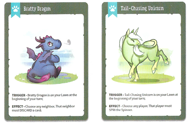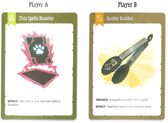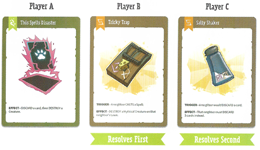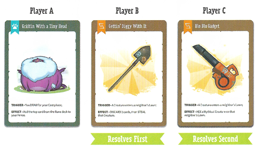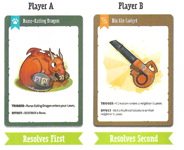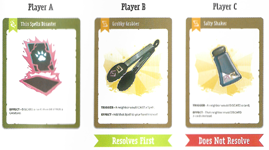Difference between revisions of "Runes and Regulations Advanced Rules"
| Line 1: | Line 1: | ||
| − | <span style="color:red">Please note that this section of the rules starts to get quite technical. Many players prefer to dice into the game without reading this section. If you've made it this far, you know everything you need to start playing. Use this section as a resource if there is confusion when multiple players want to use effects at the same time. Most of these situations can be resolved intuitively during game play, but occasionally, they get a little hairy.</span> | + | <span style="color:red">'''Please note that this section of the rules starts to get quite technical. Many players prefer to dice into the game without reading this section. If you've made it this far, you know everything you need to start playing. Use this section as a resource if there is confusion when multiple players want to use effects at the same time. Most of these situations can be resolved intuitively during game play, but occasionally, they get a little hairy.'''</span> |
---- | ---- | ||
Revision as of 13:34, 10 November 2019
Please note that this section of the rules starts to get quite technical. Many players prefer to dice into the game without reading this section. If you've made it this far, you know everything you need to start playing. Use this section as a resource if there is confusion when multiple players want to use effects at the same time. Most of these situations can be resolved intuitively during game play, but occasionally, they get a little hairy.
The Effects
TRIGGERED VS CONTINUOUS EFFECTS Some cards state a trigger and an effect. You can choose to use the effects of these cards at the time the trigger occurs. If you forget to use an effect at the time a trigger occurs and gameplay continues, you may not go back and use the effect later unless the trigger occurs again. You are a sorcerer, not a time-traveler.
If a card has a continuous effect, that effect is always active and does not require a trigger.
EFFECTS WITH A PRICE Some effects require you to play a price in order to use them. If you cannot pay this price, you cannot use the effect. Some effects with a price include:
- EFFECT: DISCARD a card, then DESTROY a Creature. (You cannot use this effect if you do not have a card in your hand to DISCARD).
- EFFECT: SACRIFICE a Mythical Creature, then SUMMON a Creature from the discard pile onto your Lawn. (You cannot use this effect if you do not have a Mythical Creature on your Lawn to SACRIFICE).
- EFFECT: Each player must RETURN a Creature to their hand. (You cannot use this effect if one or more players does not have a Creature on their Lawn to RETURN).
IMPOSSIBLE ACTIONS Sometimes the effect of a card already on your Lawn or a Spin result may require your to perform an impossible action. If this situation occurs, disregard that action. Some impossible actions include:
- DISCARD a card when you have no cards in your hand.
- RETURN a Mythical Creature when you have no Mythical Creatures on your Lawn.
RULE-MODIFYING EFFECTS Some card effects modify the rules of the game. In these cases, always follow the rules stated on the card rather then the printed rules of the game. Some rule-modifying effects include:
- CONTINUOUS EFFECT: Your hand limit is increased by 2.
- EFFECT: Skip your Spin phase.
The Order of Resolution
| Sometimes, the effect of a card is triggered by the effect of another card. When this happens, an effect chain is formed. Each effect is considered its own link in an effect chain. You must resolve the effect of the first link before moving on to the next link in the chain. All links in the effect chain must resolve before gameplay continues. |
| EXAMPLE: You SUMMON The Handsomest Pegasus during your Summon phase and use its effect to STEAL Sparkly Dragon. When Sparkly Dragon enters your Lawn, you use its effect to CAST Just For the Hex of it, choosing to HEX Teeny Tiny Manticore in a neighbor's Lawn. After Teeny Tiny Manticore has been hexed, gameplay continues and you may proceed to your Spin phase. |
| There are times when multiple effects may be triggered simultaneously, such as during your Beginning of Turn phase. All of these effects are considered to be a single link in the effect chain. Any targets of these effects must be chosen before this link in the effect chain resolves. |
| EXAMPLE: Bratty Dragon and Tail-Chasing Unicorn are on your Lawn during your Beginning of Turn phase. You must choose targets for both effects before either effect resolves. |
| If you resolve an effect which is triggered when another action "would happen," the effect of that action is nullified. |
| EXAMPLE: Player A plays This Spells Disaster. Player B ACTIVATES Grubby Grabber. The effect of This Spells Disaster is nullified, and Player B adds This Spells Disaster to their hand. |
| If multiple effects are triggered during the same turn phase, those effects are resolved in the order in which their triggers occurred. |
| EXAMPLE: Player A plays This Spells Disaster. Player B wants to ACTIVATE Tricky Trap and Player C wants to ACTIVATE Salty Shaker. Because Player A played a Spell before discarding a card, Tricky Trap resolves before Salty Shaker. Since the resolution of Tricky Trap does not conflict with the resolution of Salty Shaker, both of these Runes can resolve successfully. |
| If two or more effects are triggered simultaneously, resolution proceeds clockwise from the player who is currently taking their turn. |
| EXAMPLE: Player A plays Griffin with a Tiny Head. Player B wants to ACTIVATE Gettin' Diggy With It and Player C wants to ACTIVATE Blo Blo Gadget. Since Gettin' Diggy With It and Blo Blo Gadget state the same trigger, resolution proceeds clockwise, starting with Gettin' Diggy With It and proceeding to Blo Blo Gadget. Since the resolution of Gettin' Diggy With It does not conflict with the resolution of Blo Blo Gadget, both of these Runes can succeddfully resolve. |
| If a card's effect has been triggered but has not yet been resolved, that card cannot be chosen as the target of a different card's effect. |
| EXAMPLE: Player A plays Rune-Eating Dragon. Player B wants to ACTIVATE Blo Blo Gadget. Since the effects of Rune-Eating Dragon and Blo Blo Gadget would be triggered simultaneously, resolution proceeds clockwise, starting with Rune-Eating Dragon; However, Player A cannot choose Blo Blo Gadget as the target for Rune-Eating Dragon because Blo Blo Gadget has already been triggered. After Rune-Eating Dragon's effect has been resolvedm Blo Blo Gadget can resolve normally. At this point, Player B can choose Rune-Eating Dragon as the target for Blo Blo Gadget because Rune-Eating Dragon's effect has already resolved. |
| If a player tries to ACTIVATE a Rune but it does not resolve, that player must add their Rune back to their Fence. |
| EXAMPLE: Player A plays This Spells Disaster. Player B wants to ACTIVATE Grubby Grabber and Player C wants to ACTIVATE Salty Shaker. Because Player A would play a Spell before discarding a card, Grubby Grabber resolved before Salty Shaker. In this case, the resolution of Grubby Grabber prevents the resolution of Salty Shaker since Player A will no longer DISCARD a card. As such, Salty Shaker cannot resolve successfully, so Player C must return Salty Shaker to their Fence. |

